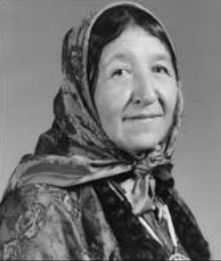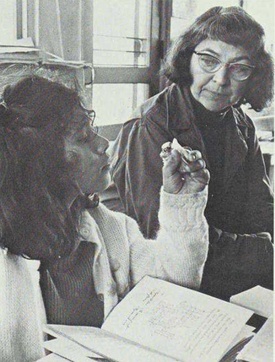Related Research Articles

Annie Dodge Wauneka was an influential member of the Navajo Nation as member of the Navajo Nation Council. As a member and three term head of the council's Health and Welfare Committee, she worked to improve the health and education of the Navajo. Wauneka is widely known for her countless efforts to improve health on the Navajo Nation, focusing mostly on the eradication of tuberculosis within her nation. She also authored a dictionary, in which translated English medical terms into the Navajo language. She was awarded the Presidential Medal of Freedom in 1963 by Lyndon B. Johnson as well as the Indian Council Fire Achievement Award and the Navajo Medal of Honor. She also received an honorary doctorate in Humanities from the University of New Mexico. In 2000, Wauneka was inducted into the National Women's Hall of Fame.
Rudolph Carl Gorman was a Native American artist of the Navajo Nation. Referred to as "the Picasso of American Indian artists" by The New York Times, his paintings are primarily of Native American women and characterized by fluid forms and vibrant colors, though he also worked in sculpture, ceramics, and stone lithography. He was also an avid lover of cuisine, authoring four cookbooks, called Nudes and Food.

The Occupation of Alcatraz was a 19-month long protest when 89 Native Americans and their supporters occupied Alcatraz Island. The protest was led by Richard Oakes, LaNada Means, and others, while John Trudell served as spokesman. The group lived on the island together until the protest was forcibly ended by the U.S. government.

Washington Matthews was a surgeon in the United States Army, ethnographer, and linguist known for his studies of Native American peoples, especially the Navajo.

Ádahooníłígíí was a Navajo-language monthly newspaper that was published in the Southwestern United States from 1943 to 1957. After the Cherokee Phoenix, operating from 1828 to 1834, it was the second regularly circulating newspaper in the United States that was written in a Native American language. It was the first newspaper to be published in Navajo and the only one to have been written entirely in Navajo. In April 2019, roughly 100 issues of the newspaper were digitized as a part of the University of Arizona Library's National Digital Newspaper Program and they are currently available online.
Indian rolling is the assault, and in some cases murder, of often homelessNavajo and Apache individuals committed by non-Indians in the Southwestern United States, especially in the border towns surrounding the Navajo Nation and Jicarilla lands. In her 2006 dissertation, Lisa Donaldson classifies Indian rolling as a "thrill-seeking hate crime" and traces its roots to the colonization of the Southwest which created a "power differential between groups that led to negative feelings toward minorities among law enforcement and local citizens".
Dorothy Lonewolf Miller was a Blackfoot activist from Iowa. She was a union organizer, social worker and health care advocate, who participated in the Alcatraz occupation, providing support at the health clinic established on the island. She spent 40 years researching social issues and providing social services to Native Americans, children, prisoners, and mental health patients in California and was posthumously inducted into the California Social Work Hall of Distinction in 2004.
Dorothea Cross Leighton was an American social psychiatrist and a founder of the field of medical anthropology. Leighton held faculty positions at Cornell University and the University of North Carolina and she was the founding president of the Society for Medical Anthropology. She and her husband, Alexander Leighton, wrote The Navajo Door, which has been described as the first written work in applied medical anthropology.

Marie C. Cox was a Comanche activist who worked on legislation for Native American children. She received many accolades for her efforts including the 1974 Indian Leadership Award from the Bureau of Indian Affairs and state recognition that same year as the Outstanding Citizen of Oklahoma from Governor David Hall. She was named as an Outstanding Indian Woman of 1977 by the North American Indian Women's Association, and served on the National Advisory Council on Indian Education from 1983 to 1990. In 1993, she was inducted into the Oklahoma Women's Hall of Fame for her work with foster children and the founding of the North American Indian Women's Association.

Susie Walking Bear Yellowtail (1903–1981) (Crow-Sioux) was the first Crow and one of the first Native Americans to graduate as a registered nurse in the United States. Working for the Indian Health Service, she brought modern health care to her people and traveled throughout the U.S. to assess care given to indigenous people for the Public Health Service. Yellowtail served on many national health organizations and received many honors for her work, including the President's Award for Outstanding Nursing Health Care in 1962 and being honored in 1978 as the "Grandmother of American Indian Nurses" by the American Indian Nurses Association. She was inducted into the Montana Hall of Fame in 1987 and in 2002 became the first Native American inductee of the American Nurses Association Hall of Fame.

Veronica Murdock is an American civil servant and of Shasta–Mohave ancestry, as a member of the Colorado River Indian Tribes. She served in the tribal administration, including as vice chair, of the Colorado River Tribe from 1969 to 1979 and between 1977 and 1979 as the first woman president of the National Congress of American Indians. From 1980 to 2004, she served as a civil service employee with the Bureau of Indian Affairs.
Patty Talahongva is a Hopi journalist, documentary producer, and news executive. She was the first Native American anchor of a national news program in the United States and is involved in Native American youth and community development projects. A past president of the Native American Journalists Association, she was the recipient of their Medill Milestone Achievement Award in 2016. In 2019, she was hired as the news executive for the national television news program developed by Indian Country Today at Arizona State University.
Margaret Wood is a Navajo-Seminole fiber artist, fashion designer, and quilt maker. Though she began her career as a teacher and librarian, Wood switched to fiber arts to allow her to express her creativity. She published Native American Fashion: Modern Adaptations of Traditional Designs, which for four decades was the only book focused on traditional native clothing and how it was modified in contemporary design. From 1990, Wood primarily became a quilter, displaying her works at numerous featured exhibitions throughout the United States, including such venues as the American Craft Museum in Manhattan; the Heard Museum of Phoenix, Arizona; the Riverside Metropolitan Museum of Riverside, California and the Wheelwright Museum of the American Indian of Santa Fe, New Mexico, among many others.
Joyce Begay-Foss is a Diné weaver, educator, and curator. She is the director of education at the Museum of Indian Arts & Culture. For her weavings, she has received more than 20 awards at the Santa Fe Indian Market and Eight Northern Pueblos arts and crafts show.
Katherine Spencer Halpern was an American anthropologist and educator.

Stella Leach was a Colville-Oglala Lakota nurse and activist who was known for her work in establishing the first American Indian children's wellness center in the San Francisco Bay Area, setting up the health clinic during the Occupation of Alcatraz, and her activism for native American self-determination.
Henrietta Mann is a Native American academic and activist. She was one of the designers of the University of California, Berkeley, the University of Montana and Haskell Indian Nations University's Native American studies programs. In 2000 she became the first American Indian to hold the endowed chair of Native American studies at Montana State University and was honored with the Montana Governor's Humanities Award. She retired in 2004 and became a special advisor to the president of Montana State University.

Woesha Cloud North was an American artist, teacher, and activist. She taught in the Palo Alto Public schools from 1961 to 1969 and then assisted in running the school during the Occupation of Alcatraz. From the early 1970s, she began to teach at the university level, teaching art at San Francisco State College, the University of Nebraska–Lincoln, and California State University, Fresno. Throughout her life, she was active in women's organizations and organizations focused on indigenous people. Posthumously, her service was honored with an induction into Stanford's Multicultural Alumni Hall of Fame in 1995.
Jill Jim is an American (Navajo) health administrator and epidemiologist serving as executive director of the Navajo Department of Health. She is a member of U.S. President Joe Biden's COVID-19 Advisory Board.
Trudy Ann Griffin-Pierce was an American medical anthropologist, writer and artist. At the time of her death she was an associate professor of anthropology at the University of Arizona.
References
Citations
- 1 2 3 4 5 Parsons 1976, p. 9.
- 1 2 The Farmington Daily Times 1978, p. 4.
- ↑ The Farmington Daily Times 1983, p. 2.
- ↑ The Albuquerque Journal 1963, p. C14.
- ↑ Johnson 1996, p. 89.
- ↑ Hamilton 1970, p. 30.
- ↑ University of Arizona 2014.
- 1 2 3 Kaur 2012, p. 282.
- ↑ The Arizona Daily Sun 1987, p. 2.
- ↑ Cannella 1994, pp. A1, A6.
- ↑ Urban Indian Health Commission 2007, p. 36.
- ↑ Urban Indian Health Commission 2007, p. 1.
Bibliography
- Cannella, David (December 5, 1994). "Breaking Barriers That Hurt Minorities' Health: Different Cultures often a Hurdle (pt. 1)". The Arizona Republic . Phoenix, Arizona. p. A1. Retrieved August 26, 2020– via Newspapers.com. and Cannella, David (December 5, 1994). "Cultural Differences Hurt Minority Health (pt. 2)". The Arizona Republic . Phoenix, Arizona. p. A6. Retrieved August 26, 2020– via Newspapers.com.
- Hamilton, Mildred (October 5, 1970). "Indians Decide It Is Time". The San Francisco Examiner . San Francisco, California. p. 30. Retrieved August 25, 2020– via Newspapers.com.
- Johnson, Troy R. (1996). The Occupation of Alcatraz Island: Indian Self-determination and the Rise of Indian Activism. Urbana, Illinois: University of Illinois Press. ISBN 978-0-252-06585-9.
- Kaur, Judith Salmon (2012). "About the Editors and Contributors". In Joe, Jennie R.; Gachupin, Francine C. (eds.). Health and Social Issues of Native American Women. Santa Barbara, California: ABC-CLIO. pp. 277–288. ISBN 978-0-313-39714-1.
- Parsons, Cynthia (February 13, 1976). "Indians Suffer Culture Shock". The Albuquerque Journal . Albuquerque, New Mexico. The Christian Science Monitor News Service. p. 9. Retrieved August 25, 2020– via Newspapers.com.
- Urban Indian Health Commission (2007). Invisible Tribes: Urban Indians and Their Health in a Changing World (PDF) (Report). Seattle, Washington: Robert Wood Johnson Foundation. Archived (PDF) from the original on July 24, 2020. Retrieved August 26, 2020.
- "15 Years Ago". The Farmington Daily Times . Farmington, New Mexico. December 24, 1978. p. 4. Retrieved August 26, 2020– via Newspaperarchive.com.
- "American Indian Museum Picks Board". The Navajo Times . Window Rock, Arizona. April 5, 1990. p. 23. Retrieved August 26, 2020– via Newspaperarchive.com.
- "Commissioned Officer". The Albuquerque Journal . Albuquerque, New Mexico. December 6, 1963. p. C14. Retrieved August 26, 2020– via Newspaperarchive.com.
- "Education Official Praises NAU Native American Study". The Arizona Daily Sun . Flagstaff, Arizona. November 9, 1987. p. 2. Retrieved August 26, 2020– via Newspapers.com.
- "Jennie Joe". American Indian Studies. Tucson, Arizona: University of Arizona. 2014. Archived from the original on January 1, 2016. Retrieved August 25, 2020.
- "Jennie Joe Receives PhD from Cal-Berkeley". The Navajo Times . Window Rock, Arizona. September 18, 1980. p. 14. Retrieved August 26, 2020– via Newspaperarchive.com.
- "Joe". The Farmington Daily Times . Farmington, New Mexico. April 7, 1983. p. 2. Retrieved August 26, 2020– via Newspaperarchive.com.